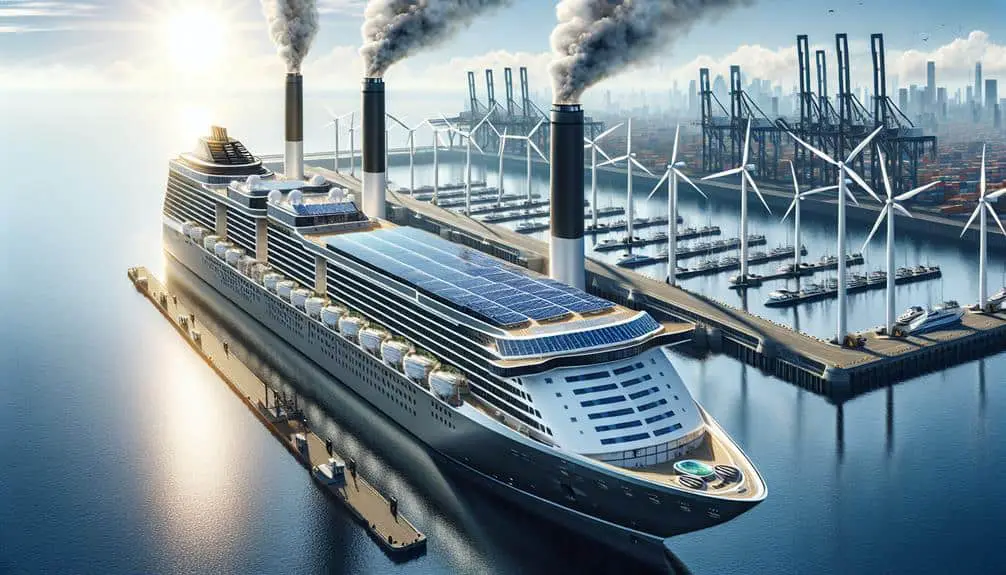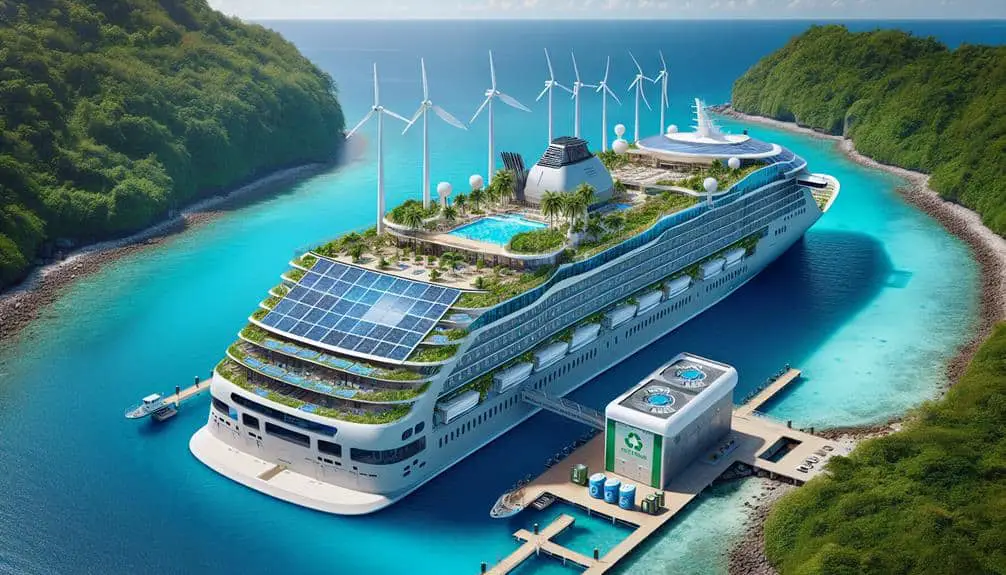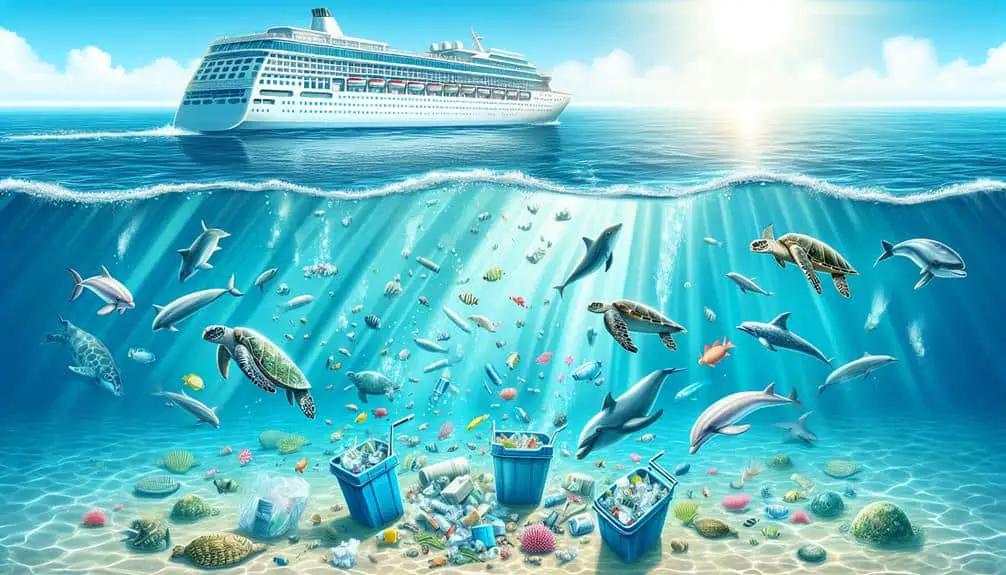Embrace sustainable cruise ship design with cutting-edge technology. Incorporate renewable power sources like solar panels and wind turbines. Integrate advanced recycling systems for efficient waste management. Opt for eco-friendly materials such as recycled plastics to reduce environmental impact. Implement water-saving strategies like rainwater harvesting and greywater recycling. Incorporate biodiversity protection measures for long-term ecological sustainability. These innovative approaches minimize environmental impact and enhance sustainability.
Key Points
- Integration of renewable energy sources like solar panels and wind turbines.
- Implementation of advanced waste management systems for efficient recycling and waste disposal.
- Use of eco-friendly materials such as recycled plastics and biodegradable composites.
- Adoption of water conservation strategies like rainwater harvesting and greywater recycling.
- Incorporation of biodiversity protection measures through advanced wastewater treatment and marine conservation efforts.
Green Energy Solutions
To maximize efficiency and reduce environmental impact, sustainable cruise ship designs incorporate advanced green energy solutions. Renewable power sources play a pivotal role in powering these vessels, with technologies such as solar panels and wind turbines becoming increasingly prevalent. Solar panels installed on the ship's deck harness sunlight and convert it into electricity, providing a clean and sustainable source of power. Similarly, wind turbines strategically positioned on the ship utilize wind energy to generate additional electricity, further reducing the reliance on traditional fuel sources.
Energy-efficient technologies are also integral to sustainable cruise ship designs. Advanced propulsion systems optimize fuel consumption, reducing emissions and operating costs. LED lighting systems are used throughout the ship to minimize energy consumption while maintaining adequate illumination levels. Additionally, smart HVAC systems regulate temperature more efficiently, utilizing sensors to adjust settings based on occupancy and external conditions.
Waste Management Systems
Sustainable cruise ship designs integrate sophisticated waste management systems to efficiently handle onboard waste disposal and promote environmental stewardship. To optimize waste management practices, cruise ships have implemented various strategies, including:
- Advanced Recycling Innovations: Utilizing state-of-the-art technology to sort, process, and recycle different types of waste materials onboard.
- Composting Techniques: Implementing composting systems to reduce organic waste and produce nutrient-rich soil for use in onboard gardens.
- Waste Segregation Protocols: Establishing strict protocols for separating recyclables, organic waste, and non-recyclable materials to streamline the waste disposal process.
- Efficient Waste Incineration Systems: Installing high-efficiency incinerators to safely dispose of non-recyclable waste while minimizing environmental impact.
- Monitoring and Analysis Tools: Utilizing data-driven approaches to track waste generation rates, identify areas for improvement, and enhance overall waste management efficiency.
Eco-Friendly Materials
Incorporating eco-friendly materials into cruise ship construction enhances sustainability and reduces environmental impact. Utilizing recycled plastics in the manufacturing of various components such as furniture, deck surfaces, and decorative elements can notably decrease the demand for new raw materials. These recycled plastics not only divert waste from landfills but also require less energy to produce compared to virgin plastics, further reducing the carbon footprint of the cruise ship.
Additionally, incorporating biodegradable composites in non-structural elements like railings, partitions, and decorative panels can enhance the vessel's sustainability profile. These composites are designed to break down naturally over time, minimizing the environmental impact at the end of the ship's lifecycle.
Water Conservation Strategies
Utilize advanced filtration systems to optimize water consumption on the cruise ship, ensuring efficient resource management and minimizing waste. Implementing innovative water conservation strategies is important for sustainable cruise ship design. To achieve this, consider the following:
- Rainwater Harvesting: Capture and store rainwater for non-potable uses like irrigation and cleaning, reducing reliance on freshwater sources.
- Greywater Recycling: Treat and reuse greywater from sinks, showers, and laundry for tasks that don't require potable water, decreasing overall water demand.
- Smart Irrigation Systems: Utilize sensor-based technologies to deliver precise amounts of water to plants, avoiding wastage.
- Low-Flow Fixtures: Install water-efficient faucets, showers, and toilets to reduce water consumption without compromising user experience.
- Leak Detection Systems: Implement sensors to quickly identify and fix leaks, preventing water loss and ensuring efficient water usage throughout the ship.
Biodiversity Protection Measures
Implementing effective biodiversity protection measures is paramount in ensuring the long-term ecological sustainability of the cruise ship's operations. When designing cruise ships with a focus on biodiversity protection, it's essential to take into account the impact on marine habitats and the preservation of species.
To safeguard marine habitats, cruise operators can implement technologies such as advanced wastewater treatment systems to prevent pollution and reduce the introduction of harmful substances into the ocean. Additionally, utilizing environmentally friendly hull coatings can help minimize the spread of invasive species and protect the existing ecosystem.
Species preservation can be enhanced through the establishment of designated marine protected areas along cruise routes. These areas serve as sanctuaries for vulnerable species, allowing them to thrive without disturbance from human activities. Cruise ships can also contribute to species preservation by adhering to strict regulations on waste disposal and minimizing noise pollution that can disrupt marine life.
Frequently Asked Questions
How Do Sustainable Cruise Ship Designs Impact Local Communities and Ecosystems in Popular Cruise Destinations?
When sustainable cruise ship designs prioritize community engagement and ecotourism benefits, local ecosystems flourish, and communities thrive. By reducing environmental impact and fostering responsible tourism practices, these designs create a harmonious relationship between travelers and destinations.
What Measures Are in Place to Ensure the Ethical Sourcing of Materials Used in Eco-Friendly Cruise Ship Designs?
To guarantee ethical sourcing of materials in eco-friendly cruise ship designs, strict guidelines and certifications are implemented. Sustainable materials like upcycled steel and low-emission coatings are preferred. Transparency in supply chains is vital for accountability and environmental preservation.
Are There Any Innovative Technologies Being Explored for Reducing Noise Pollution From Cruise Ships in Sensitive Marine Environments?
To reduce noise pollution impacting marine life in sensitive environments, innovative technologies like advanced propulsion systems and sound-absorbing materials are being explored. These sustainable solutions offer significant benefits for protecting marine ecosystems from harmful disturbances.
How Do Sustainable Cruise Ship Designs Address the Issue of Air Pollution From Cruise Ship Emissions?
You might be amazed by how sustainable cruise ship designs tackle air pollution. Energy efficiency, emission controls, alternative fuels, and green technologies are the heroes here. These innovative solutions pave the way for cleaner, greener voyages.
What Steps Are Being Taken to Ensure the Safety and Well-Being of Marine Wildlife in Areas Where Cruise Ships Operate?
To protect marine wildlife, cruise operators implement strict protocols, such as reducing speed in sensitive areas, using sonar technology to detect animals, and educating crew members. These measures prioritize marine conservation and wildlife protection.




